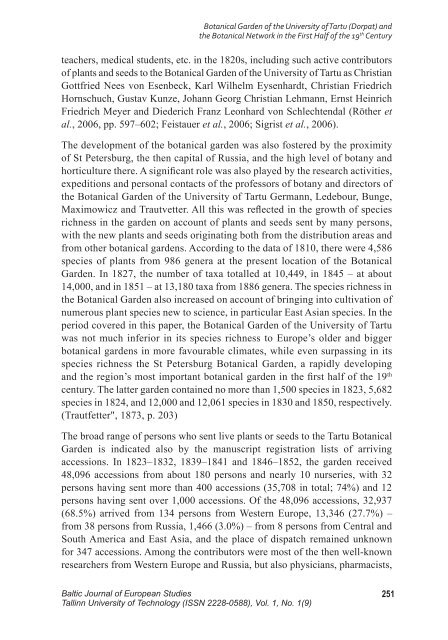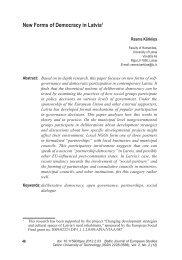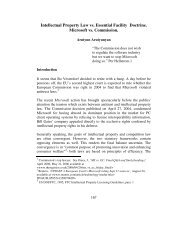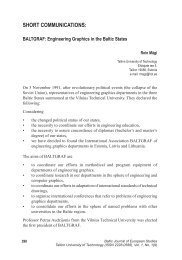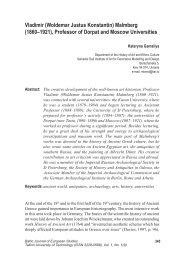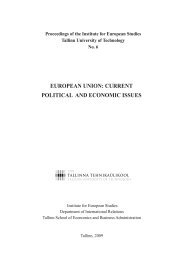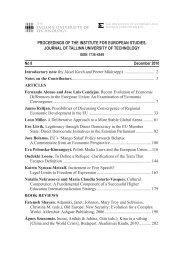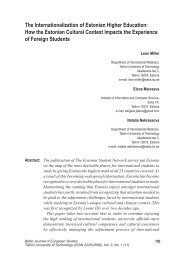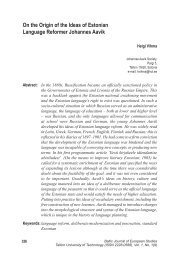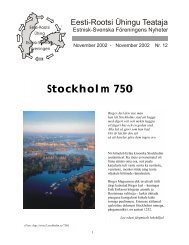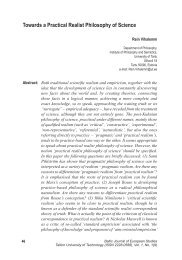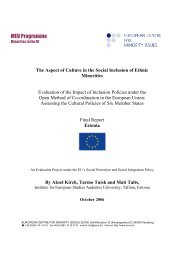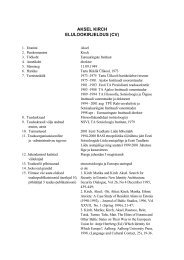Botanical Garden of the university of tartu (dorpat) - The Institute for ...
Botanical Garden of the university of tartu (dorpat) - The Institute for ...
Botanical Garden of the university of tartu (dorpat) - The Institute for ...
Create successful ePaper yourself
Turn your PDF publications into a flip-book with our unique Google optimized e-Paper software.
<strong>Botanical</strong> <strong>Garden</strong> <strong>of</strong> <strong>the</strong> University <strong>of</strong> Tartu (Dorpat) and<br />
<strong>the</strong> <strong>Botanical</strong> Network in <strong>the</strong> First Half <strong>of</strong> <strong>the</strong> 19 th Century<br />
teachers, medical students, etc. in <strong>the</strong> 1820s, including such active contributors<br />
<strong>of</strong> plants and seeds to <strong>the</strong> <strong>Botanical</strong> <strong>Garden</strong> <strong>of</strong> <strong>the</strong> University <strong>of</strong> Tartu as Christian<br />
Gottfried Nees von Esenbeck, Karl Wilhelm Eysenhardt, Christian Friedrich<br />
Hornschuch, Gustav Kunze, Johann Georg Christian Lehmann, Ernst Heinrich<br />
Friedrich Meyer and Diederich Franz Leonhard von Schlechtendal (Rö<strong>the</strong>r et<br />
al., 2006, pp. 597–602; Feistauer et al., 2006; Sigrist et al., 2006).<br />
<strong>The</strong> development <strong>of</strong> <strong>the</strong> botanical garden was also fostered by <strong>the</strong> proximity<br />
<strong>of</strong> St Petersburg, <strong>the</strong> <strong>the</strong>n capital <strong>of</strong> Russia, and <strong>the</strong> high level <strong>of</strong> botany and<br />
horticulture <strong>the</strong>re. A significant role was also played by <strong>the</strong> research activities,<br />
expeditions and personal contacts <strong>of</strong> <strong>the</strong> pr<strong>of</strong>essors <strong>of</strong> botany and directors <strong>of</strong><br />
<strong>the</strong> <strong>Botanical</strong> <strong>Garden</strong> <strong>of</strong> <strong>the</strong> University <strong>of</strong> Tartu Germann, Ledebour, Bunge,<br />
Maximowicz and Trautvetter. All this was reflected in <strong>the</strong> growth <strong>of</strong> species<br />
richness in <strong>the</strong> garden on account <strong>of</strong> plants and seeds sent by many persons,<br />
with <strong>the</strong> new plants and seeds originating both from <strong>the</strong> distribution areas and<br />
from o<strong>the</strong>r botanical gardens. According to <strong>the</strong> data <strong>of</strong> 1810, <strong>the</strong>re were 4,586<br />
species <strong>of</strong> plants from 986 genera at <strong>the</strong> present location <strong>of</strong> <strong>the</strong> <strong>Botanical</strong><br />
<strong>Garden</strong>. In 1827, <strong>the</strong> number <strong>of</strong> taxa totalled at 10,449, in 1845 – at about<br />
14,000, and in 1851 – at 13,180 taxa from 1886 genera. <strong>The</strong> species richness in<br />
<strong>the</strong> <strong>Botanical</strong> <strong>Garden</strong> also increased on account <strong>of</strong> bringing into cultivation <strong>of</strong><br />
numerous plant species new to science, in particular East Asian species. In <strong>the</strong><br />
period covered in this paper, <strong>the</strong> <strong>Botanical</strong> <strong>Garden</strong> <strong>of</strong> <strong>the</strong> University <strong>of</strong> Tartu<br />
was not much inferior in its species richness to Europe’s older and bigger<br />
botanical gardens in more favourable climates, while even surpassing in its<br />
species richness <strong>the</strong> St Petersburg <strong>Botanical</strong> <strong>Garden</strong>, a rapidly developing<br />
and <strong>the</strong> region’s most important botanical garden in <strong>the</strong> first half <strong>of</strong> <strong>the</strong> 19 th<br />
century. <strong>The</strong> latter garden contained no more than 1,500 species in 1823, 5,682<br />
species in 1824, and 12,000 and 12,061 species in 1830 and 1850, respectively.<br />
(Trautfetter", 1873, p. 203)<br />
<strong>The</strong> broad range <strong>of</strong> persons who sent live plants or seeds to <strong>the</strong> Tartu <strong>Botanical</strong><br />
<strong>Garden</strong> is indicated also by <strong>the</strong> manuscript registration lists <strong>of</strong> arriving<br />
accessions. In 1823–1832, 1839–1841 and 1846–1852, <strong>the</strong> garden received<br />
48,096 accessions from about 180 persons and nearly 10 nurseries, with 32<br />
persons having sent more than 400 accessions (35,708 in total; 74%) and 12<br />
persons having sent over 1,000 accessions. Of <strong>the</strong> 48,096 accessions, 32,937<br />
(68.5%) arrived from 134 persons from Western Europe, 13,346 (27.7%) –<br />
from 38 persons from Russia, 1,466 (3.0%) – from 8 persons from Central and<br />
South America and East Asia, and <strong>the</strong> place <strong>of</strong> dispatch remained unknown<br />
<strong>for</strong> 347 accessions. Among <strong>the</strong> contributors were most <strong>of</strong> <strong>the</strong> <strong>the</strong>n well-known<br />
researchers from Western Europe and Russia, but also physicians, pharmacists,<br />
Baltic Journal <strong>of</strong> European Studies<br />
Tallinn University <strong>of</strong> Technology (ISSN 2228-0588), Vol. 1, No. 1(9)<br />
251


